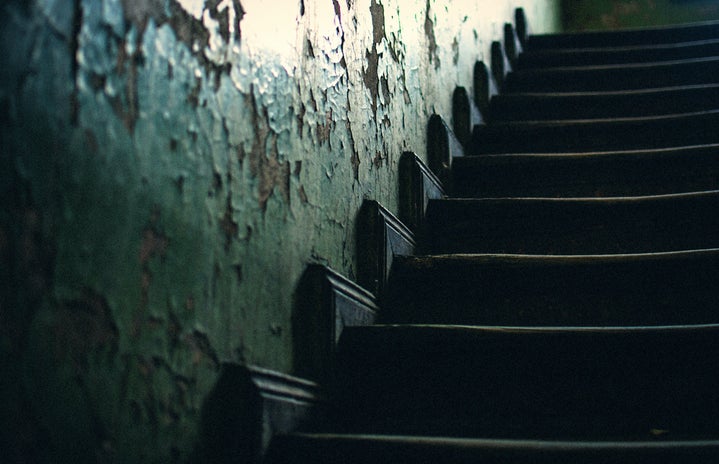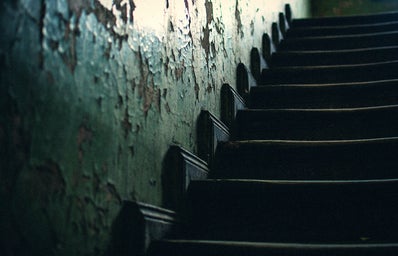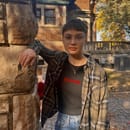The University of Missouri-Kansas City has a haunted house. Campus tour guides even tell students about the tale, but what exactly happened there?
Long before they dared the perils of World War Two, the cadets of Epperson House are said to have trained alongside a ghost. In 1942, the young men made themselves at home in the oak and walnut paneled rooms of the house, likely marveling at their luck of getting assigned to such a magnificent dormitory. With over fifty rooms for them to explore, including a billiards room, a Grecian-tiled pool and an expansive great hall, the Epperson House was a work of careful, delicate art. But within those halls, a different story was looming.
While the men roomed in the house in the off-time of their naval training, a mysterious ghost woman in a luminous white gown began to visit them. According to their reports, she appeared to be pacing the tall hallways of the mansion. Spooked, the cadets were the first to tell Kansas City of her existence and give Epperson House a haunted reputation.
Years prior in the early 1920s, Uriah and Mary Epperson were making plans for their lavish Kansas City castle. Mr. Epperson was a distinguished insurance tycoon with a round face, dainty spectacles and a bushy mustache. Both he and his wife were passionate patrons of the arts, which perhaps is the reason for their extravagant choices when building their new home. They imagined hosting plays and entertaining guests in a spectacular grand hall, impressing all of their friends. After being shown 1,500 house plans, the couple finally chose the design we know today that perfectly suited their taste. Mrs. Epperson was an avid traveler and for her, a room named “the Elephant Room” was created to house her travel collections. According to pictures sourced from the U.S. Epperson Collection of the UMKC Digital Special Collections, the room was filled with beautiful elephant statues and figurines.
Little did the Eppersons know, however, that they would barely get any time to enjoy their new castle once it was built. In 1922, a woman named Harriet Barse moved into the newly finished mansion alongside Uriah and Mary Epperson. She was an organ instructor at the Kansas City Conservatory (now the UMKC Conservatory) and because of the Eppersons’ ties to the arts, they had formed a close relationship with her, going as far as to call her their “adopted daughter.” They even had a custom pipe organ constructed in the mansion just for her.
Unfortunately, the same year she moved into the house, Harriet Barse died at the age of 47. Her official reason for death was a perforated gallbladder from a failed operation, but many have speculated that it may not be the truth—or at least the whole truth. Due to the wounds on Harriet’s abdomen, some believe that she could have died from a botched home abortion. However, this remains a rumor since there is no way to know if that was really the case.
Barely five years later in 1927, Uriah Epperson also passed away. In the decades afterward, people whispered that he had a mental breakdown over the death of Harriet and killed his wife and then himself. The three were said to now be tied together for eternity haunting Epperson House.
Whether or not you believe in ghosts, I’m sorry to say that the ways in which the Eppersons actually died are not cohesive with the stories. Mary Epperson didn’t actually pass away until over ten years later in 1939 of cancer and Mr. Epperson did not die by suicide but of a stroke. The house was donated to UMKC in 1942 during World War Two and became housing for the cadets. After the war, it would be repurposed into everything from a residency hall, practice rooms and office spaces.
Over the years, Epperson House has known many temporary purposes, but none were as permanent as its ghosts are said to be. Reports of hauntings have been cropping up frequently since 1942. In fact, last year marks the Eppersons and Harriet Barse’s eightieth year haunting the house.
It seems the hauntings have only become creepier as time passes. In the 1970s when the house was a residency hall, students reported hearing the ghost of Harriet Barse walking in empty parts of the house. Sometimes, they even heard organ music playing from the basement. They didn’t just claim to hear her though. Students reported that they saw Harriet in a white gown similar to a choir robe and occasionally even holding a baby, a link to her rumored abortion.
So what about the ghosts of the Eppersons? Well, spooky reports from a few campus police officers may make the ghost stories more credible. During a routine walkthrough of the house, one officer claimed to see a ghostly hand claw out of the darkness and turn off a light. He reported the arm attached to it was wearing a man’s blue suit. In another incident, an officer was driving near the house early in the morning when another vehicle came out of nowhere and hit his car. He heard glass shatter, and when he got out of his car to investigate he saw skid marks on the grass, but the other vehicle had disappeared.
While today the Epperson House sits idle on the edge of campus, it is no question the stories of its past are iconic Kansas City lore. Whether they are authentic, however, may never be entirely clear. Were Mr. and Mrs. Epperson and Harriet Barse extraordinarily unlucky, or were their deaths more than just misfortune? Are the reports of the hauntings true or were they just campfire stories to spook students?
The Epperson House is off-limits for visitors. Perhaps today the ghosts of the house finally have some peace as they remain undisturbed in the home they built for their little family a hundred years ago.


